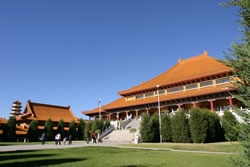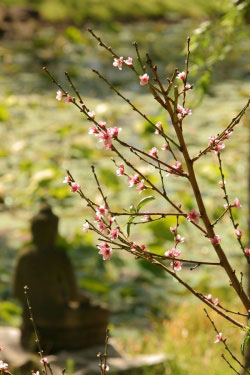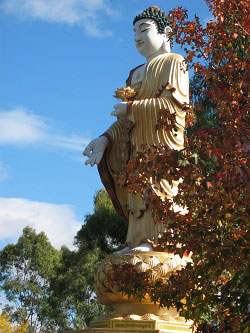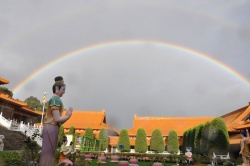Nan Tien Temple
| Nan Tien Temple | |
|---|---|
The Temple | |
| Information | |
| Tradition/Linage | Chinese, Pureland |
| Main School | Mahayana |
| Sub School | Chinese, Pure Land |
| Founded | Founded(when)::1991/11/28 |
| People | |
| Teacher(s) | BUORG-Names::Names::Abbess Yi Lai |
| Contact Infotmation | |
| Address | 180 Berkeley Road Berkeley New South Wales 2506 Australia |
| Country | Australia |
| Coordinates | service=google }} {{#geocode:180Berkeley RoadBerkeleyNew South WalesAustralia|format=float|service=google}} service=google }}The "_geo" type of this property is invalid |
| Map | {{#display_map:{{#geocode:180Berkeley RoadBerkeleyNew South WalesAustralia}}|height=250px|width=250px|zoom=18}} |
| Phone | Phone::(02) 4272 0600 |
| Fax | Fa(02) 4272 0601::(02) 4272 0601 |
| Website | Website::http://www.nantien.org.au/en/about-us/nan-tien-temple "Website" has not been listed as valid URI scheme. |
| Email::info@nantien.org.auURIs of the form "Email::info@nantien.org.au" are not allowed., Email::nantien@fgs.org.auURIs of the form "Email::nantien@fgs.org.au" are not allowed. | |
| Postal Address | PostalAddress::PO Box 1336, PostalAddress::Unanderra, PostalAddress::N.S.W 2526, PostalAddress::Australia |
,
About
Situated at Berkeley - a suburb of Wollongong in the state of New South Wales. It is one of the branch temples of Fo Guang Shan, founded in 1965 by Venerable Master Hsing Yun, which has over 200 branches worldwide. "Nan Tien" in Chinese, literally means "Paradise of the South". This is the biggest Buddhist temple in the southern hemisphere.
Since the opening of the temple in October 1995, it has become a new venue for local and international tourists and also acts as an important cultural centre bridging different cultures.
Fo Guang Buddhism is rooted in the Mahayana tradition which emphasises that Buddhahood is within everyone's potential reach. Fo Guang followers strive to bring Buddhism into daily life and aptly term their faith "Humanistic Buddhism."
History
Since the establishment of Fo Guang Shan, the number of people practicing Buddhism has been increasing around the word. Under the guidance of respectable and renowned Master Hsing Yun, 120 Fo Guang Shan branches were opened over 5 continents, one of which, the Nan Tien Temple, the largest in the Southern Hemisphere, is situated in the Wollongong area in NSW, Australia.
In 1990, the Mayor of Wollongong discussed the plan and supported the idea of building a Buddhist temple on the approval and assistance of all council members. Land of an area of 26 acres was then donated for building the temple. The ground breaking ceremony took place on the 28th November 1991 and the project started in 1992. This project took 5 years planning and 2 years construction.
Architecture
Nan Tien temple will take its role in bridging the East-West cultures. The Temple has adopted the Chinese palace building style, bringing tradition and modern ideas into one. There are 4 principle characteristics as follows:
1. Traditional and Modern
The Main Shrine has 5 large serene Buddha's surrounded by 10,000 smaller Buddha's giving a unique touch of Duong Hwang classic arts. Other modern facilities include classrooms, the meditation hall, the Pagoda for cremated ashes, auditorium and a dining hall for all visitors. To pioneer Buddhist teachings a conference room is equipped with the latest technology with excellent translation facilities. A car-park for 300 cars is provided for the convenience of visitors.
2. Participation of Monastic and Laity
Nan Tien Temple not only promotes Buddhist activities, it welcomes people from social service organisations and education institutions to participate in making a better society. Nan Tien Temple is for everyone, all can join in making an effort towards our achievements of global peace.
3. Joint-Practice of Understanding and Application
Nan Tien temple is a place for people to practice and understand the Dharma (Buddha's teachings). Dharma is in our everyday lives. People can come to the Main Shrine to pray and pay their respects to the Buddha. They may also practice meditation in the meditation hall to become further aware of one's mind and feelings, listen to the Dharma in the auditorium, and read and immerse oneself in the boundless world of Buddhist scriptures to gain wisdom. In addition, the Buddhist College offers traditional monastic training to help achieve the aim of building Buddhist localisation.
4. Combined Buddhism and Arts
Buddhism and arts are inseparable. The Museum's backdrop is a full of natural rock. There is a Kuan Yin Wishing Pond, the Mirrored Gallery of the universally interrelated world and various artifacts on display. Many educational programs include Chinese classes, calligraphy, cooking classes as well as English Buddhism classes.
At the Opening Ceremony of Nan Tien temple, the founder of Fo Guang Shan, Ven. Master Hsing Yun asserted that Nan Tien Temple should bear these 4 goals in mind: "Offer others confidence; Offer others happiness; Offers others hope; Offers others convenience". The future role of Nan Tien Temple focuses on nourishment of potential talents, serving the community with compassion, practicing Buddhism to purify one's mind and forging toward to the future with a bold spirit.
AWARD OF EXCELLENCE:
Located in a quiet, peaceful environment, overlooking Mount Keira and Mount Kembla, Nan Tien Temple has now been recognised as a wonderful place to visit. Due to its multi-functional role, the Temple has been proudly awarded for the following awards:
- 2011 - Winner of Major Tourist Attactions in South Coast Tourism Awards
- 2011 - Winner of South Coast Champion in South Coast Tourism Awards
- 2000 - First prize in the Schools/Institutions section at the Wollongong Garden Festival
- 1999 - Award of Excellence for the NSW Tourism Competition
- 1997 - Winner for Major Tourist Attraction in the Illawarra and Southern Highlands Tourism Competition
- 1996 - Award for Gardening
- 1995 - Award for Best Architecture
- 1995 - Award for Best Lighting Design
- 2014 - Gold Winner South Coast Tourism Awards
Objectives of Fo Guang Shan:
- To propagate Buddhist teachings through cultural activities
- To foster talent through education
- To benefit society through charitable programs
- To purify human hearts and minds through Buddhist practice
- Fo Guang Shan International Buddhist Order promotes Humanistic Buddhism, aiming to make Buddhism relevant in the world, in our lives, and in each one of our hearts.




